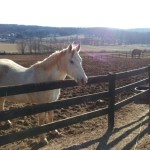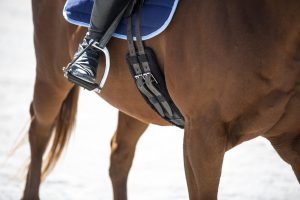If you have ever gone to a horse show or a big group trail ride, you know that the environment you take your horse in can make him behave very differently.
At home he may be relaxed and attentive, but in a new place or with other horses, he may be anxious, spooky, or seem to forget all his prior training.
Even just a windy day can trigger a change in behavior.
In today’s video, we are going to discuss why environment has such a big impact and how you can work through this problem… even use it to your advantage!
To learn more about the principles of distance, duration, and intensity in desensitizing read this article.
Also, if you enjoyed this video, share it with your friends!
See you in the comments,
Callie














15 Responses
Great explanation and suggestions as always, Callie! How do you deal with a horse that is affected by wind, maybe a brewing storm, which is a part of the environment we can’t control?
Katrin,
You are absolutely correct that often we have no control over our environment, so then we 1) have to control our own reactions to it and 2) hope we have a horse prepared to deal with the unkonwn. While we can’t train for every eventuality, we can prepare our animals to accept a variety of crazy, unusual, uncomfortable, etc things. Warwick Schiller is really big on preparing horses before they are put in a situation where they may have to face new/ unusual/ scary things, often using successive approximation, for those of you familiar with operant conditioning. Basically, start with the smallest thing that could upset the horse, then as the horse is ok with it, increase. I love how he mentions that if you increase one difficulty (duration, distance, intensity) you need to at first lower the other two. These videos may help give you some ideas. He is very step by step to prepare the horse instead of just dealing with him once he spooks. Of course you can’t train for everything, but getting the horse out of his comfort zone just a little is good for him, and teaches him to think about his fear rather than always reacting.
https://www.youtube.com/watch?v=PQ2ICfaw-0E
https://www.youtube.com/watch?v=XpeWje2rHsA
Katrin; We obviously cannot control the “natural environment” wind, rain, thunder, wildlife, etc.” But we can prepare our horse to the point where he will be tuned in to you (the rider or handler) and not all the commotion going on around him…if you train with a method that gives your horse confidence in you and teaches him to give you his attention/respect because he sees you as a good leader who will keep him safe (just as the leader of a herd will try to keep its herd safe). Desensitizing and sensitizing exercises ( usually an equal dose of each in most cases) will teach confidence and trust; and in return you’ll get respect. If you remember that horses can only think of one thing at a time and you “give him a job” (by asking him to move his feet in any of 4 directions (forward, backward, left or right) it will cause him to focus on you and your request. The “secret” to this task is in your teaching various exercises (longeing, sidepassing,yielding fore and hind quarters, backing up,etc.) that not only get the horse to “tune in” to you, but also teaches him to use the ‘thinking part of his brain’ instead of the ‘reactive side’. Directing his feet by doing different exercises (trying to use all 4 directions) will keep his mind engaged and…if longeing, lots of changes of direction (which helps him focus better) will be a huge benefit. When he complies, reward with praise, a rest/pause, or a rub. If the horse is very “keyed up” don’t quit moving his feet until you see a sign of relaxation (lowering his head, licking his lips, big sigh, are a few), otherwise you will be rewarding anxious behavior which is just opposite of what you want! After every “sensitizing” exercise (these are skills that ask him to MOVE his feet), do a desensitizing exercise (skills that require his feet to stay STILL while you toss a lead rope over his body, shake a plastic bag, run clippers, etc.)
Of course you wouldn’t just go to a first horse show, or out on the trail on a blustery day without teaching the horse some skills at home in his familiar (and quiet) environment as Callie talked about! Up the “ante” in increments as you train different skills (using all 4 directions as mentioned) by increasing the pressure/intensity (scariness) around him until the horse will allow you to desensitize him (he should NOT move his feet when you desensitize) in lots of different controlled (scary) environments that you set up….bags, tarps, flags, umbrella, balloons, whip cracking or other noises…etc. If your horse allows you to do ground work exercises with these objects (and more…be creative!) while you sensitize and desensitize him, then go to “under saddle” starting over with the least scary environment and building up to most scary again. Let your horse tell you when he’s ready to handle more intensity! If you stay calm (remember to breathe) and make sure your horse is able to handle each step before moving to the next (more difficult) step, then you should have a pretty high success rate for remaining in control of you horse in all scary situations.
Always have a plan before you jump in with both feet (or all 4 if you’re on your horse!) Hope this helps.
Hi Katrin,
Thanks for your comment and question! The key is really in finding what helps your horse relax in stressful situations. Is it movement as Judy recommended or is it asking to stand still? Often asking for and getting responses to easy requests such as walk forward, back up, small circles, little leg yields, etc build rapport between horse and human. They do help the horse to focus on the handler, not because they can only think of one thing at a time, but rather that having a clear task can be anxiety relieving for horses as well as people.
I do want to say that I would be careful thinking that when a horse sees us as “leader” they will be calm and responsive in any situation. This isn’t true in horse social life and I believe that building a good relationship with our horse so they can respond and trust us in stressful situations is much more about creating many positive interactions with the horse and being clear in how we communicate and ask for responses, not about trying to establish a role as a herd leader.
yes i wonder about wind also Katrin, we have a lot of wind lately. I choose to do ground work for my lesson because I knew the horse would spook ‘Or a good chance of it, It does make me wonder about horses that live outside and how they deal with it, or horses that work all day.
Corinne, we have had bad weather for months. I am in WA and my horses are outside 24/7. I can’t ride for about 6 months out of the year due to the almost constant rain and slippery footing. The horses are so “on edge” it is terrible. Can’t wait for summer!
Distance, duration and intensity. So good. It makes sense and I understand why I do better with my horse in the indoor arena than I do in the outdoor. NOW, to make a habit of not avoiding the outdoor. Thanks for this video.
thank you again for sharing, very helpful as always!
Understandable, I don’t like windy days either. Windy days are for sailing not riding.
This is the first time in a long time that I have been able to listen to Callie’s videos and I find that there is always a huge store of good information that I really need. I’ve been working Zara with a trainer (in western reining and dressage) and he is really good. It’s really intense work (hence no time to watch online videos 🙁 ) BUT one thing he doesn’t do is desensitization training. He believes in giving the horse a job that brings his/her attention on you. I have found that using an approach/retreat method in working with crazy stimuli has worked very well with Zara – which is what I am taking away with Callie’s video – starting at the quietest place to work your horse to calm them down. I feel really good about what I’ve been doing with Zara because not only have I had great success in calming Zara down, but Callie has essentially confirmed that it’s the right thing to do. Thanks, Callie!
I didn’t say everything I intended … What I meant was that the combination of working the horse with things that you usually do plus starting at a distance from the stimuli is what has worked really well for me. I hope this is more clear. Wind? Zara has never been bothered by the wind. The day I first rode her before I bought her we were having one of the craziest windy days – gusts up to 45 mph, as I recall. What gets to her are the things that flap in the wind. And I have also found that dripping water – like from melting snow, ice, etc – from metal bleachers is also a huge fright for her. But I have a plan for that.
LOL! We sure have had a lot of wind this year! I stay on the ground during those times because it’s too cold- which means I ground train. Good chance to walk by all those things flapping in the wind- keeping distance, duration and intensity in mind.
Do you have any advice for a horse that doesn’t like tacking up? I rode a horse like that yesterday, and she listens very well on the lesson. I only have to have a crop in my hand and she already speeds up! The only bad thing about her is that she hates and I mean absolutely hates tacking up. She’ll start throwing her head everywhere and trying to bite me when I try to put anything on her back (blanket, saddle, saddle pad etc). It’s even harder when I’m trying to put the bridle on.
Any help? Pleeeeease?
First, the tack has to be comfortable and put on nicely, it’s always worth mentioning that if the tack is uncomfortable or if the bit is being banged against teeth by other students, she has good reason to act irritated during tacking up. If everything is comfortable and it’s just habit, then look to break down each step rewarding with a small treat for standing still and relaxed. The treats help to create more positive associations around the whole tacking up process too.
Thank you! My instructor said that it’s a habit of hers, so I’ll ask her if I can give her treats for standing still. Thank you once again.